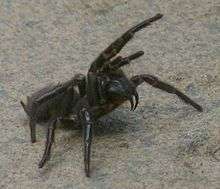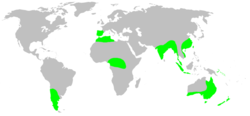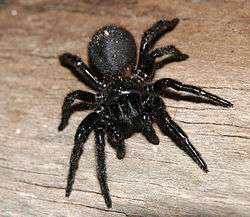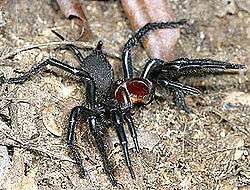Hexathelidae
| Hexathelidae venomous funnel-web spiders | |
|---|---|
 | |
| Female Sydney funnel-web spider | |
| Scientific classification | |
| Kingdom: | Animalia |
| Phylum: | Arthropoda |
| Class: | Arachnida |
| Order: | Araneae |
| Suborder: | Mygalomorphae |
| Infraorder: | Tuberculotae |
| Superfamily: | Hexatheloidea |
| Family: | Hexathelidae Simon, 1892 |
| Genera | |
|
See text. | |
| Diversity | |
| 11 genera, 85 species | |
 | |
Hexathelidae[1] is the only family in the superfamily Hexatheloidea,[2] and one of two families (along with Dipluridae) of spiders known as funnel-webs. This order is sometimes incorrectly referred to (in unknown references) as the venomous funnel-web tarantulas, due to the inclusion of the Australian funnel-web spiders, including the Sydney funnel-web spider (Atrax robustus). Most species in Hexathelidae are not dangerous to humans.
Description

These spiders are medium-to-large in size, with body lengths ranging from 1 to 5 cm (0.5 to 2 in). The body is typically three times longer than it is wide. They are darkly colored, ranging from black to brown, with a glossy carapace covering the front part of the body. Like the related diplurid spiders, the hexathelids have generally long spinnerets; this is especially true of A. robustus. The eyes of these spiders are close together.
Their moderately long posterior spinnerets and other features make the Hexathelidae appear similar to the Dipluridae, and were considered a subfamily of the latter until 1980.[4]
Like other Mygalomorphae (also called the Orthognatha, an infraorder of spiders which includes the true tarantulas), these spiders have fangs which point straight down and do not cross each other (see also Araneomorphae). They have ample venom glands that lie entirely within their chelicerae. Their chelicerae and fangs are large and powerful. Although they are rather small compared to the true tarantulas, as venomous specimens they should not be handled without taking substantial precautions because their fangs have been known to penetrate fingernails and soft shoes, resulting in dangerous bites.[5]
Range and habitat
Most hexathelids are found in Australia, New Zealand, and Asia. One species is known in the Mediterranean region and two from South America. Two species exist in Central Africa.
Hexathelids typically live in burrows, which are constructed in the ground or in tree hollows. An elaborately constructed burrow entrance is common. These spiders construct a funnel shaped web and lurk for prey in the small end of the funnel. They frequently search for a place to nest under human dwellings, or under nearby rocks, logs, or other similar objects. They are most active at night. Some build in rainforest, both in the soil and in hollows on trees; others build entirely in sand, e.g., Fraser Island, southeastern Queensland. In Australia, these spiders tend to prefer cooler climates and hence are found primarily in rainforest [6]
Most species live in rainforests, but they also exist in other habitats, from sea level to high up in the mountains.[7]
Medical significance
There are four genera known to contain medically significant spiders —Atrax, Illawarra and Hadronyche of Australia, and Macrothele, which contains some species considered dangerous in Taiwan and parts of eastern Asia.
Genera
The categorization into subfamilies follows Raven, 1985.


- Hexathelinae Simon, 1892
- Bymainiella Raven, 1978 — Australia
- Hexathele Ausserer, 1871 — New Zealand
- Mediothele Raven & Platnick, 1978 — Chile
- Paraembolides Raven, 1980 — Australia
- Rosamygale † Selden & Gall, 1992 — (fossil, Triassic)
- Rosamygale grauvogeli † (Selden & Gall, 1992)
- Scotinoecus Simon, 1892 — Chile, Argentina
- Teranodes Raven, 1985 — Australia
- Atracinae Hogg, 1901 — Australia
- Atrax O. P-Cambridge, 1877 — Australia
- Hadronyche L. Koch, 1873 — Australia
- Illawarra Gray, 2010 — Australia
- Macrothelinae Simon, 1892
- Macrothele Ausserer, 1871 — Africa, Europe, Asia
- Porrhothele Simon, 1892 — New Zealand
- Plesiothelinae Raven, 1980
- Plesiothele Raven, 1978 — Tasmania
See also
Footnotes
- ↑ Raven, R.J. (1980) The evolution and biogeography of the mygalomorph spider family Hexathelidae (Araneae, Chelicerata). J. Arachnol. 8: 251-266.
- ↑ Raven, R.J. 1985. The spider Infraorder Mygalomorphae (Araneae): cladistics and systematics. Bulletin of the American Museum of Natural History 182: 1-180.
- ↑ Museum Victoria: Victorian Funnel-web Spider
- ↑ Raven, R.J. 1980. The evolution and biogeography of the mygalomorph spider family Hexathelidae (Araneae, Chelicerata). Journal of Arachnology. 8: 251-266.
- ↑
- ↑ Gray, M.R. 1987. Distribution of the funnel web spiders. In Covacevich, J., P. Davie & J. Pearn (eds.), Toxic plants and animals: A guide for Australia. Queensland Museum, Brisbane, pp. 312-321.
- ↑ Murphy & Murphy 2000: 68
References
- Raven, Robert John (1985). The spider Infraorder Mygalomorphae (Araneae): cladistics and systematics. Bulletin of the American Museum of Natural History 182: 1-180.
- Find-a-spider guide
- Raven, R.J. & Platnick, N.I. (1978): A new genus of the spider family Dipluridae from Chile (Araneae, Mygalomorphae). J. Arachnol. 6: 73-77. PDF (Mediothele, now in Hexathelidae)
- Murphy, Frances & Murphy, John (2000): An Introduction to the Spiders of South East Asia. Malaysian Nature Society, Kuala Lumpur.
- Platnick N I (2008): The world spider catalog, version 8.5. American Museum of Natural History.
External links
| Wikispecies has information related to: Hexathelidae |
| Wikimedia Commons has media related to Hexathelidae. |